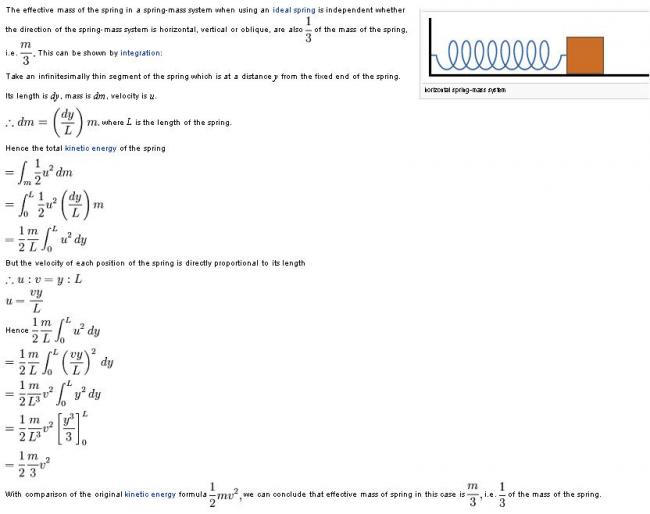Just adding one ques :
Why do we always take collisions with springs to be inelastic ?
A block of mass M travelling at velocity v m/s strikes on a spring of mass m on a horizontal table. Find the maximum compression.
-
UP 0 DOWN 0 1 30

30 Answers
i dunno wat hes posted i just read the question and posted answer...too many posts abv...
@iitiamcoming
dats wat eure has posted na..
@varun
wat do u mean by
"k includes m/3" ....???
1/2Mv^2 + K.E of spring = 1/2 k x^2.........................(1)
break the spring into various segments .................(of length dx)
now vel. of each segment = v (x / l) x= distance from the point to which the spring is fixed.............................
dm=dx/l*m
1/2*dm*V^2= 1/2* dx*v^2*x^2*m/(l^3)
integrating from 0 to l
K.E OF SPRING = m*v^2/6
well i think the best solution is this ..... when it is compressed by a distance x some of th k e of the block appears as the k e of the spring so we hv to find the pnt when the vel of the blokc is 0 ... this is the basic theory behind
now k haas already been calculated so we can apply 1/2mv^2=1/2kx^2 and k includes m/3
maybe i cracked my own ques....becoz we are consdierng max compression and for that we need a continuous force to be applied on spring thus compressing it...and which will only come once the KE of block starts reducing and gets converted to potential energy of spring..so complete inelastic
and regarding that why we take always inelastic....i think reson should be that since we need max compression..so till taht point block will remain in contact with spring...so they would have same velocity (as they would have crossed equilibrium instant)....and after max compression the spring will surely decompress and will release the block(which is obvious)
now someone plz confirm what i said above...though everything looks obvious now...
ya i also do think its a genuine doubt....lets see if i can find the ans....
I too thought the same...""hamesha se aisa karte aaye hai" [3][3]
but just while working out this ques...this thought came to my mind...i hope its genuine dbt..
ohk i get the point now...but cant think of the reason....its just dat "hamesha se aisa karte aaye hai" and never really tried to think of the reason...!!!
what i am saying is that....we all everytime consider that block sticks to spring ..and write moemntum eqn with mass of block and spring combined ...why so ???the body may suffer inelastic collison
(REMEMBER that inelastic is diff from completely inelastic) and get send back....so we cant conserve momentum then ??or can we ??
i hope its all not so confusing [1]
so what if collison is not completely ineleastic ??then also there will be some loss of energy .....which can be converted to potenital energy mainly and some neglible heat energy...
but why we assume completely elastic collision like everyone is doing above here????
@aveek
wait some tym for the explanation....
@eureka
springs include loss of energy in an inelastic collision, which gets converted to potential energy in the spring in this case and Inelastic collisions are always in which the colliding objects stick together
oyeeee rogue shabash yaar............now u gotta explain !!!!!!!!!!!!!!!!!!!!!!!!!!!!!!!!!!!!!!!!!!!!!!!!!!!!!!!!!!!!!!!!!!!!!!!!!!!!!!!!!!!!!!!!!!!!!!!!!!!!!!!!!!!!!!!!!!!!!!!
nope. there will be a velocity that will be of both the spring and the mass.
@Philip : i dunno d answer. just some 3M+m will come as numerator. and the entire thing will be under root
As far as i know...the method involves an integration.....nothing more
Sorry guys the spring is fixed at one end. Otherwise how can there be a maximum compression without friction ????
1/2 [mv2 - (m+M)v'2] = 1/2 kx2
cancelling two does not give the same thing as in # 8 [3]
certainly, some more specifications are needed !
we cannot assume anything !
Not so easy guyzzz........this one from FIITJEE corresp. course
